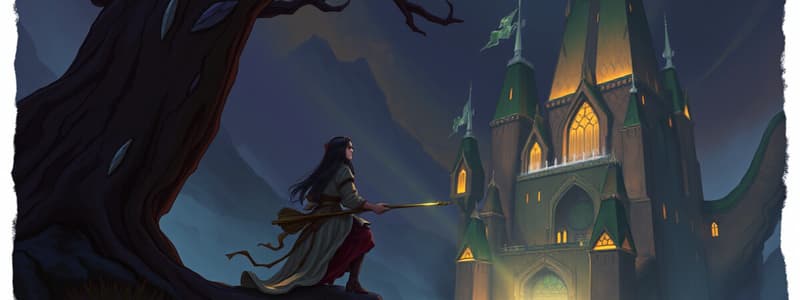Podcast
Questions and Answers
Protagonists are characters that oppose the main character.
Protagonists are characters that oppose the main character.
False (B)
The climax of a story is the stage where the conflict is at its highest intensity.
The climax of a story is the stage where the conflict is at its highest intensity.
True (A)
Implicit themes are clearly articulated by the author and leave no room for interpretation.
Implicit themes are clearly articulated by the author and leave no room for interpretation.
False (B)
Setting includes not only the geographical location but also the time period in which the story occurs.
Setting includes not only the geographical location but also the time period in which the story occurs.
Identifying main ideas in a narrative is an essential skill for reading comprehension.
Identifying main ideas in a narrative is an essential skill for reading comprehension.
Flashcards are hidden until you start studying
Study Notes
Narrative Text Study Notes
Character Development
- Definition: The process by which a character is introduced, evolves, and is portrayed throughout the narrative.
- Types of Characters:
- Protagonist: Main character facing challenges.
- Antagonist: Opposes the protagonist.
- Static Characters: Remain the same throughout the story.
- Dynamic Characters: Experience significant change.
- Techniques:
- Direct Characterization: Explicitly states traits.
- Indirect Characterization: Shows traits through actions, dialogue, and interactions.
Plot Structure
- Components:
- Exposition: Introduction of characters, setting, and initial conflict.
- Rising Action: Development of conflict; events build tension.
- Climax: Turning point; highest intensity of conflict.
- Falling Action: Aftermath of the climax; leads towards resolution.
- Resolution: Conflict is resolved and the story concludes.
- Narrative Arcs: Can be linear or non-linear, affecting how the story unfolds.
Theme Analysis
- Definition: Underlying message or central idea within the narrative.
- Identification:
- Explicit Themes: Clearly articulated by the author.
- Implicit Themes: Suggested through elements of the story.
- Common Themes: Love, conflict, redemption, identity, morality, and the human condition.
- Importance: Themes provide deeper understanding and provoke thought.
Setting Description
- Definition: The time and place in which the story occurs.
- Elements:
- Physical Location: Geography, scenery, and environment.
- Temporal Context: Time period, season, or cultural background.
- Mood and Atmosphere: Emotional quality created by the setting.
- Function: Enhances the narrative, influences characters’ actions, and reflects themes.
Reading Comprehension
- Skills Required:
- Identifying Main Ideas: Understanding central concepts and themes.
- Analyzing Characters and Events: Making connections and drawing conclusions.
- Making Inferences: Reading between the lines to understand implicit meanings.
- Summarizing: Condensing information while retaining key points.
- Strategies:
- Preview the Text: Skim headings and summaries.
- Ask Questions: Engage with the text for deeper understanding.
- Visualize: Create mental images of setting and characters.
- Reflect: Consider personal connections and reactions to the text.
Character Development
- Character development is the introduction and evolution of characters throughout a narrative.
- Protagonist is the main character who must face and overcome challenges.
- Antagonist is the character that opposes the protagonist, creating conflict within the story.
- Static characters do not undergo any changes, remaining the same from start to finish.
- Dynamic characters undergo significant transformation or growth during the story.
- Direct characterization involves explicitly stating a character's traits, making it clear to the reader.
- Indirect characterization reveals traits through actions, dialogue, and interactions with other characters.
Plot Structure
- Exposition introduces key characters, setting, and initial conflict, establishing the groundwork for the story.
- Rising action involves the development of conflict as events build tension and complexity.
- Climax serves as the turning point of the story, where the conflict reaches its peak and the outcome hangs in the balance.
- Falling action follows the climax and deals with the consequences, leading toward the resolution.
- Resolution resolves the main conflict, providing closure to the narrative.
- Narrative arcs can be linear, with a straightforward timeline, or non-linear, where events are presented out of chronological order.
Theme Analysis
- Theme is the central idea or underlying message that runs throughout the narrative.
- Explicit themes are directly articulated by the author, making them clear to the reader.
- Implicit themes are suggested through story elements and require interpretation by the reader.
- Common themes found in narratives include love, conflict, redemption, identity, morality, and exploration of the human condition.
- Understanding themes deepens engagement with the text and provokes critical thought.
Setting Description
- Setting refers to the time and place in which the story is set, contributing to the overall narrative context.
- Physical location encompasses geographical, scenic, and environmental details crucial to the context of the story.
- Temporal context includes time period, season, or cultural background influencing the narrative.
- Mood and atmosphere are emotional qualities created by the setting, impacting reader perception and character actions.
- The setting enhances the narrative, influences character actions, and reflects overarching themes.
Reading Comprehension
- Key skills for reading comprehension include identifying main ideas, making connections, analyzing characters and events, and drawing conclusions.
- Making inferences involves understanding implicit meanings by reading between the lines and interpreting underlying messages.
- Summarizing helps condense information, retaining essential points while discarding less critical details.
- Effective strategies for comprehension include previewing the text, asking questions for deeper understanding, visualizing the setting and characters, and reflecting on personal connections to the material.
Studying That Suits You
Use AI to generate personalized quizzes and flashcards to suit your learning preferences.




